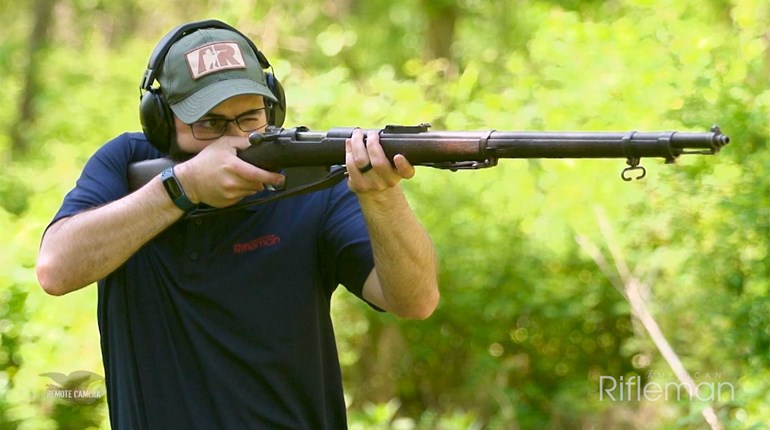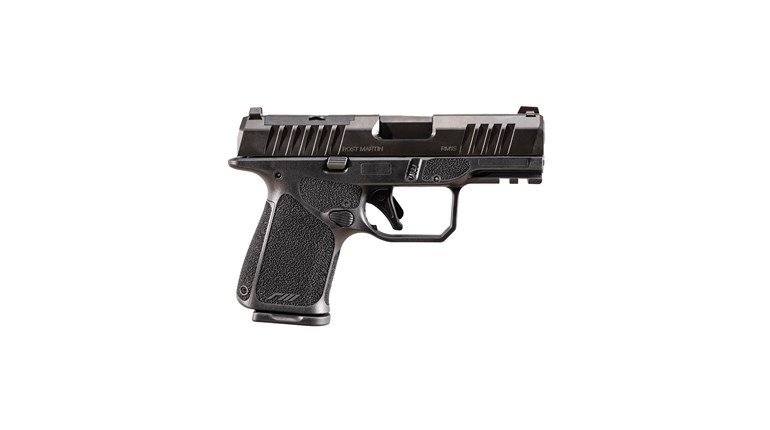
Earth-shattering evolution isn’t exactly a hallmark of the firearm industry. Imagine if Ford’s 2019 releases included a Model T complete with GPS navigation, spinner rims and a flashy paint job. Sure, it looks kind of new and modern, but at its heart, it’s still a Model T. Many of today’s “modern” guns are, at heart, designs from 50- or 100-odd years past. So, the emergence of non-NFA-regulated, short-barrel, shotshell-firing firearms—an entirely new product category—is a rare opportunity to observe the development of a never-before-seen self-defense setup. In the new, semi-automatic Remington Tac-13, that system might just have reached its zenith.
The rise of shotshell-firing platforms like the Mossberg Shockwave, Remington Tac-14 and now the new Remington Tac-13 isn’t really the result of normal market forces at work. Nobody ever said, “Hmm, you know what? I want a shotgun I can’t shoulder. By the way, I want aiming to be super hard, and I want it to be in this pseudo pistol-grip configuration.” Rather, manufacturers sought to produce a more-compact platform based on their popular shotguns while remaining within the regulatory confines of the National Firearms Act of 1934.
Mossberg was one of the first companies to develop this non-NFA platform by combining its pump-action 590 receiver with a shortened, 14.375-inch barrel and the Shockwave Raptor birdshead pistol grip. Remington followed by adapting its Model 870 receiver to use the same grip, along with a shortened barrel. This grip does two things: First, the gun ships from the factory in a configuration not designed for use against the shoulder, the inclusion of a shoulder stock being one of the defining features of an NFA-regulated short-barrel shotgun. Second, the angled grip lengthens the platform enough to exceed an NFA-required minimum overall length of 26 inches.

Thus, rather than filling a specific consumer need, Remington and Mossberg alike developed a platform that fit the bill. The whole process, from a consumer standpoint, emerged as somewhat backward compared to traditional product development. Now, the question became, “How do I use this? What is it good for?” In his September 2017 review of the Mossberg Shockwave, Shotgun Editor Jeff Johnston outlined his thought process behind compact shotshell-firing platforms like these, touting the use of ammo and accessories like lights, lasers and low-recoil Aguila Minishells to create an easily handled, well-outfitted platform for home defense.
It’s important to understand the background details that determine the Tac-13’s place in the hierarchy of this relatively new arena of defensive firearms, and thanks to the semi-automatic setup of the Tac-13, that place is pretty near the top. Why? Up until this point, these non-NFA guns have all been built on pump-action designs, a feature that, to me at least, somewhat limits their capabilities in the personal-defense realm.
Part of this limiting factor comes with the fact that these guns are most-comfortably fired from the hip, thanks to the unique angle of the Shockwave Raptor grip. When shooting from the hip, users will naturally aim higher than they intend, to which a busted-up 2x4 target hanger on the NRA Publications range can attest. Of course, this can be moderated by practice, but instinctive aiming under stress, which will happen in a home-defense situation, may lead to shots being fired higher than anticipated. To mitigate misses, users won’t want to push shots much beyond the width of your average living room or master bedroom, say around 5 or 6 yards.

So, if these guns are best-used at across-the-room distances and are really best-applied to home protection and maybe close-range varmint dispatching, then we’ve got a very narrow set of practical circumstances to which this kind of firearm is suited. An attacker at 5 yards is going to close that distance within the space of a second, barring any intervening obstacle. That’s where benefits of the semi-automatic action on the Remington Tac-13 comes into play, allowing rounds to be fired with each trigger pull and nothing more. Until this point, Remington and Mossberg have been neck-and-neck in the shotshell-firing firearm category, with both manufacturers offering similarly constructed, pump-action models.
In addition to its Model 500 and 590 pump-action mechanisms, Mossberg also produces a semi-automatic shotgun in the form of its Model 930. Many consumers have asked why Mossberg hasn’t released a semi-automatic version of the Shockwave based on this tried-and-true receiver. The problem lies in the mechanism of the 930, which is dependent on a lengthy return spring located within the stock to function. This return spring can’t easily be adapted to fit in the short Shockwave grip without a significant redesign of the entire system. Remington, however, has an arena-dominator in the form of its V3 receiver.

Unlike the Mossberg 930, the Remington V3 semi-automatic mechanism actually uses a dual recoil-spring setup that’s contained entirely within the receiver rather than using the space within the stock. The guide rods for this design bottom out at the end of the aluminum receiver, so there are no internal mechanisms protruding from the rear of the gun, allowing Remington to attach any kind of stock or pistol grip it wants.
Another innovative feature found in the Remington Tac-13 is the VersaPort gas system, which allows the semi-automatic mechanism to “self-regulate,” meaning it can automatically adjust the amount of propellant gases flowing into the dual-piston mechanism located just under the barrel. The key to this self-regulation can be found in the form of four ports located at the front of the chamber, which are easily seen from the breech end of the barrel. With 2 3⁄4-inch shotshells, all four ports are exposed, allowing the maximum amount of gas to flow into the system for reliable cycling. With a heavier, 3-inch shell, the longer shell covers two of the four ports, compensating for the increased pressure and gas flow created by magnum shells and preventing an overgassed system from suffering increased wear from heavier defensive loads.
At this point, readers might worry this gas system leaves room for potential malfunctions from low-recoil, low-brass defensive loads that don’t produce as much energy as traditional 2 3⁄4-inch shotshells. Fortunately, I got my hands on a few boxes of low-recoil defensive loads from Remington and PMC and ran every round through without issue. In fact, the Remington Tac-13 handled every brand of shotshell I fed it without hiccupping, including light field loads from Aguila and Winchester to personal-defense shells from Hornady and Federal Premium.
During our range sessions, one of the other benefits of the semi- automatic mechanism over the more-traditional pump-action mechanism emerged. When firing a pump-action gun like the Remington Tac-14, every internal mechanism is locked into place during the firing process. That means shooters will become quite familiar with Mr. Newton’s Third Law, as every bit of energy sending the shot forward also comes back into the user’s hand. On the Remington Tac-13, however, a portion of that energy is expended in driving the bolt rearward, so you’ll bleed off some of that recoil impulse and save your wrist. Though there is a marked difference, don’t think this will make a 3-inch magnum feel like field loads. Trust me, you’ll still feel it.

What’s more, shooting sessions did highlight one particular brand of fodder that’s a non-starter in the Tac-13. In his review of the Mossberg Shockwave, Johnston focused on the 1 3⁄4-inch Aguila Minishell that, when used in conjunction with the OpSol MiniClip, allows the Shockwave to reliably feed and fire these reduced-length shotshells that increase capacity to an incredible nine rounds. The Remington Tac-13, however, will not feed Aguila Minishells from the magazine, as the rounds tumble rearward when ejected from the magazine tube onto the shell carrier. Even if they did feed reliably, the reduced-recoil shells don’t produce enough energy to fully cycle the action, and singly fed Minishells often ended up poking out of the side of the receiver, having been caught by the rapidly returning bolt. If you love Aguila Minishells, stick to the Mossberg Shockwave.
In terms of magazine capacity, though, the Remington Tac-13 is no slouch. When using standard-length, 2 3⁄4-inch shotshells, five can fit into the magazine with a sixth in the chamber, providing plenty of fight-stopping power available as fast as a user’s trigger finger will allow. Since the mechanism isn’t relying on a support-hand to rack in a fresh round, that frees up that hand to do more. When firing, an included forearm strap offers a secure spot to place the free hand on the gun. There are a couple reasons to always use this included strap.

First, the Tac-13 is only 26.5 inches long, and it’s possible to have your support hand slip in front of the muzzle while firing, leading to a really bad day. The strap functions as a low-profile hand stop, preventing that hand from traveling into dangerous territory. Second, the hand strap helps to control muzzle rise, which becomes much more of a management concern on the Tac-13 versus pump-action systems. On a pump, there’s time for rise and recoil to dissipate. Not so with the semi-automatic. However, since a support hand doesn’t have much else to do but fight that muzzle rise, shooters can solidify that support by adopting a C-clamp-style grip to push the gun down during firing.
In a home-defense scenario, having a free hand is a game-changer, and it’s a benefit that pump-action shotgunners can’t enjoy without effectively turning their home-defense gun into a momentary single-shot. With the Tac-13, users can open doors, corral family members, flip on lights and much more, all while being secure in the knowledge that the gun will fire and reload without the need for two hands. However, the limiting factor here is weight. Unloaded, the Tac-13 weighs 6 pounds, and six rounds of defensive 00 buck adds heft, particularly toward the muzzle end. It’s not a platform many can hold up, single-handedly, for more than a few seconds, but a few seconds of firing with the Tac-13 can launch every shotshell downrange, if needed.
With all these elements in play, it’s clear the introduction of the Remington Tac-13 to the expanding market of non-NFA, shotshell-firing guns broadens consumer choices more than ever before. The expanded choices don’t come without cost, though. Literally. Selling at an MSRP of $915, the Tac-13 is twice as much as comparably sized, pump-action alternatives. For that added cost, though, consumers get a compact, reliable, personal-defense arm that can be maneuvered deftly and operated easily while retaining the awesome power of 00-buck defensive loads.








































